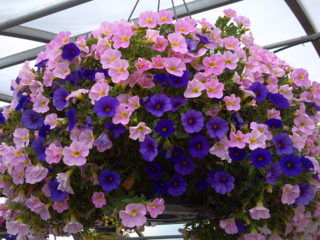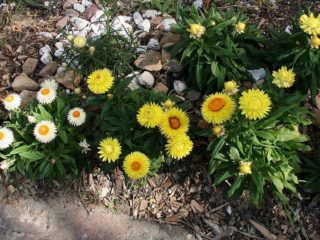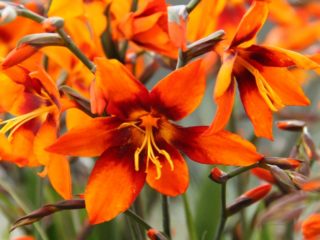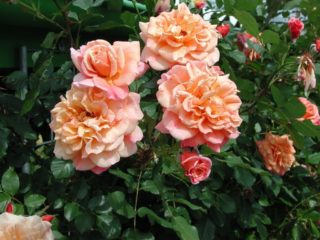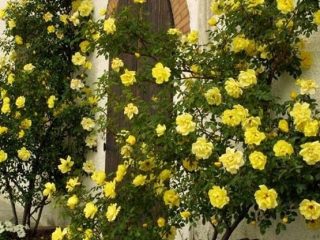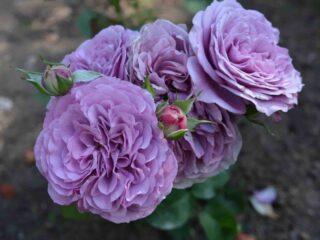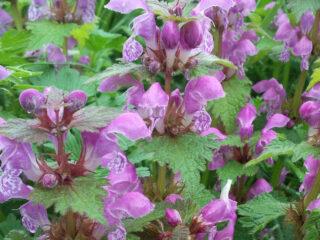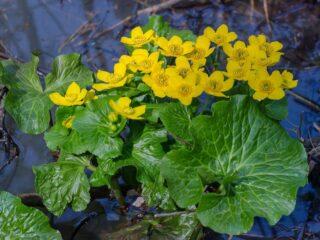Content
Thornless roses are a type of decorative perennial that enjoys special love among landscape design creators. They perfectly decorate parks, alleys and flower beds in personal plots. Flowers can grow either independently or become part of a variety of compositions and go well with many plants. Some varieties are suitable for cutting and making bouquets; there are specimens with a persistent aroma and completely odorless.
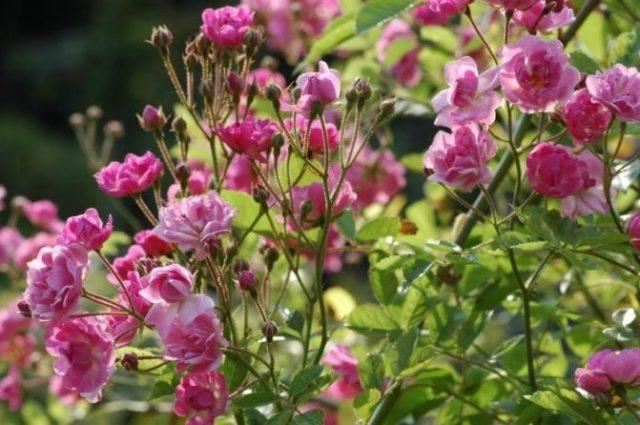
Roses without thorns may have no thorns at all, or may be covered with them, but very sparingly.
Are there roses without thorns?
Not all gardeners know about the existence of thornless roses, but it turns out that they exist and are quite widespread in some regions. Outwardly, they are very similar to the classic varieties, only they belong to a special gardening group. In this case, the prickly growths are either completely absent on them, or they are present, but soft, small, few in number and easily deformed when pressed.If thorns are present, then, in particular, only at the bottom of the shoot, and the higher to its top, the fewer they become.
Advantages and disadvantages
Roses without thorns, despite their positive qualities, have a fairly large list of disadvantages that you should familiarize yourself with before growing the crop.

Typically, roses without thorns are planted on the territory of school and preschool institutions, near sanatoriums and boarding houses.
Advantages:
- ease of care;
- abundant and long flowering;
- beautiful appearance of the bushes;
- variety of color palette;
- bright leaf blades;
- availability of propagation by cuttings;
- ability to recover after freezing.
Flaws:
- single flowering per season;
- susceptibility to disease;
- susceptibility to precipitation;
- the need for good shelter for the winter.
Types of thornless roses
Roses without thorns are found in all major types of crops. There are nine groups in total:
- Shrubs (shrubs). A rose with hard two-meter shoots covered with lush but small flowers.
- Patio. The group represents small bushes (50 cm), strewn with inflorescences.
- Climbing. A special type of climbing roses without or with thorns, some varieties can reach a height of 5 m, form buds on last year's shoots.
- Polyanthaceae. Bushes with small, almost odorless buds, similar to eustomas.
- Ground cover. They differ from the classic rose by drooping shoots creeping along the ground.
- Repairers. Hybrids up to 200 cm high, with terry buds and a persistent pleasant aroma.
- Floribunda. Extensive selection of different types of roses; specimens of other groups are often confused with it.
- Hybrid tea. They are characterized by repeated flowering with single double buds or collected in brushes.
- Standard ones.They are grown on a support; their shape resembles a small tree with a bright crown of flowers.
Thornless varieties of roses with photos and names
Roses without thorns are presented in a wide range, and their diversity cannot but delight fans of this decorative culture. If you choose the right variety for the growing region and carry out the recommended care for it, then it will grow and bloom profusely on the site for many years.
More detailed information about the description and characteristics of the most common varieties of roses without thorns can be found below.
Alberic Barbier
Alberic Barbier is a variety of climbing rose without thorns with large buds (up to 17 cm in diameter) of peach color, which become almost white over time. The bushes are small, 40 cm wide, 50 cm high. The variety is best suited for warm areas.
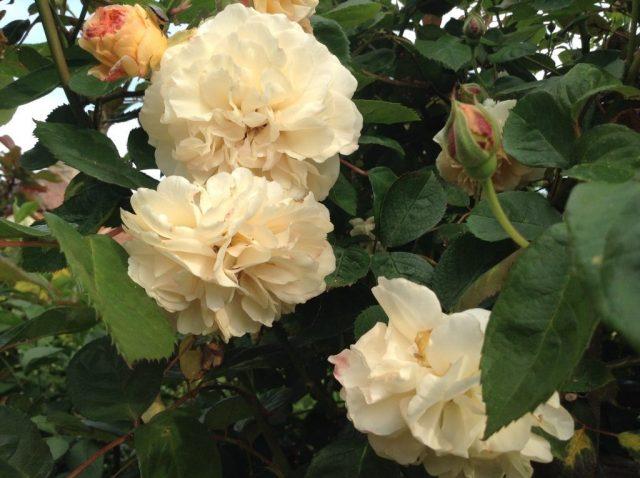
Up to three inflorescences are formed on one branch of Alberique Barbier
Paul Trenson
Paul Transon is a thornless pink rose with slightly peachy petals. The aroma of the buds is rich and persistent, flowering is triple, occurring in the second half of spring and autumn. Flowers are formed on racemes in the amount of 6-10 pieces.

Paul Trenson is a thornless bush rose, obtained more than 100 years ago by French breeders
Lakorn
Lakorn is a low-growing rose with dark, green, fairly dense foliage. Its buds are large and represent a pink palette. The variety is quite popular among thornless hybrids. Flowers are used in floristry to create compositions and bouquets.

The average height of a Lakorn rose is approximately 50 cm
Gerbe Rose
Gerbe Rose is not particularly disease-resistant, but a very beautiful rose variety without thorns. Up to 20 buds with a diameter of about 5 cm are formed on the brushes, which from a distance look like peonies. Their color ranges from soft red to crimson, and can be pink. The shoots of the variety are quite long, from half a meter.
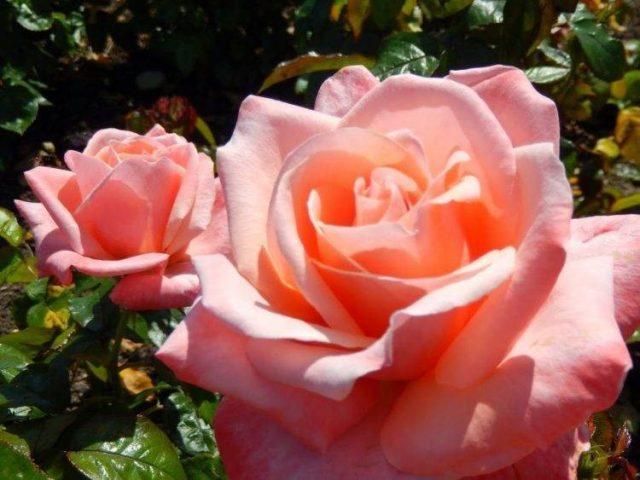
The aroma of Gerbe Rose is barely noticeable, almost absent
Wartburg
Wartburg is a powerful climbing bush with small raspberry-pink buds up to 2 cm in diameter. The flowers are double, presented in large quantities on the plant, the inflorescences consist of 30-40 pieces. The height of the variety can reach six meters.

Abundant blooming of the thornless Wartburg rose can be observed throughout the month.
Maman Turbat
Maman Turbat is a low-growing variety of polyanthus thornless rose, the maximum height of the bushes is 70 cm. The flowers are pink, collected in clusters of several pieces. The variety has good immunity and excellent frost resistance; in most areas of Russia it grows without shelter.
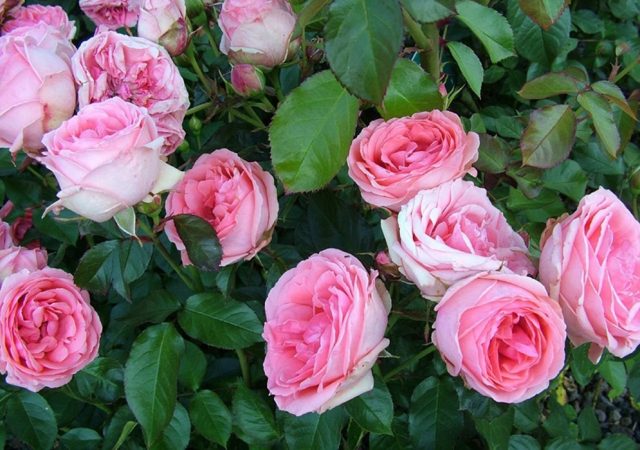
Maman Turbat is characterized by continuous flowering
Crimson Rambler
Crimson Rambler is a variety of bright red thornless rose that was bred at the end of the 19th century in Japan. The bush of this climbing variety can grow in the middle zone up to 400 cm, and in the southern regions up to 700 cm. The buds of the variety are large, with terry, slightly wavy petals, their diameter is about 8 cm.

In different countries, the Crimson Rambler rose is known by other names.
Rosalita
Rosalita (Rosalita) is a yellow rose without thorns, which is a fountain-shaped bush, reaching a height of about half a meter.The buds are small, have a bright musky aroma, collected in brushes of 10 pieces. The variety has good resistance to frost and easily tolerates winter in central Russia.
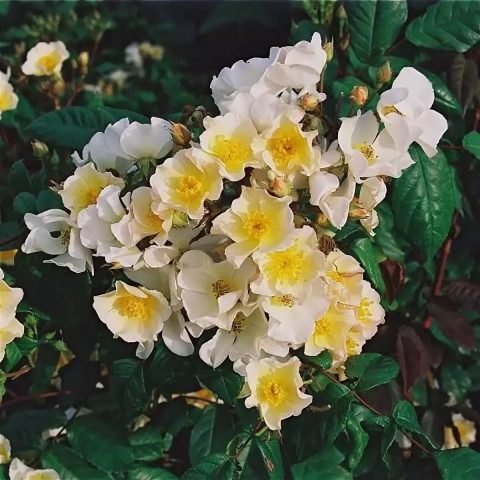
Over time, the petals of Rosalita's buds turn white
Snow Dance
Snow Dance is a variety of white rose without thorns with small, densely double buds up to 4 cm in diameter, located on powerful upright bushes. The height of the plant is about 0.8 m, width 40 cm. The flowers are great for cutting, but have practically no smell. They stay in a vase for up to one and a half weeks without losing their decorative qualities.

The Snow Dance variety is similar to floribunda, but is not
Varieties of thornless roses for the Moscow region
Quite a few varieties of roses without thorns are suitable for the Leningrad region and the Moscow region. But when choosing a plant, you should pay attention to the requirements for its cultivation. The variety should have good cold resistance and not be afraid of sudden temperature changes. The flowers of the variety must withstand weather disasters and, in the event of heavy rainfall or wind, maintain a decorative appearance. Also, preference should be given to own-rooted specimens, since grafting during frost, which is observed in the Moscow region, rarely survives until spring.
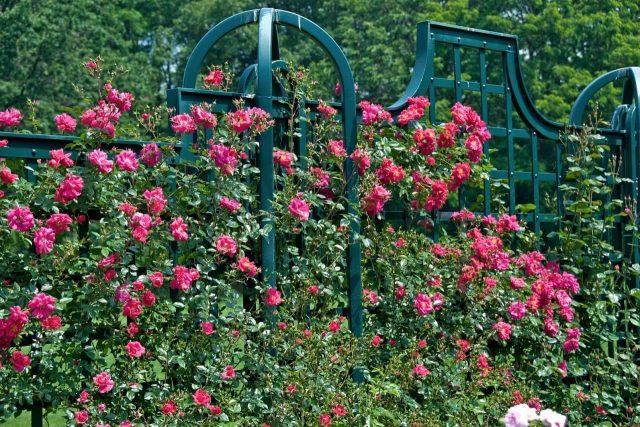
In the Moscow region, thornless roses of the Heritage and Maria Liesa varieties have proven themselves best
Features of cultivation
The main feature when growing roses without thorns is the correct selection of the variety for the cultivation region. In the northern regions and the middle zone, it is better to plant ground cover, shrub, and park varieties.If we are talking about very cold conditions, then it is reasonable to grow winter-hardy Canadian varieties of roses without thorns and Floribunda. In the southern regions there are no restrictions on the choice of varieties.
In order for roses to develop properly, it is better to plant two-year-old plants, carry out work according to the rules of agricultural technology, and then provide the recommended care to the crop. For the flower, timely, abundant watering and spraying with soft, settled water, regular (every three weeks) fertilizing with mineral complexes, and periodic pruning are important. In addition, roses without thorns need to be replanted. Young bushes are moved to a new place every two years, adults - once every five years. It is good if the surface of the earth where they grow is regularly loosened and mulched.
Since roses without thorns have average resistance to frost, in order to preserve the bushes for the winter, they should be bent to the surface of the ground and covered with non-woven material.

Young specimens are disinfected before planting
Reproduction
Roses without thorns are propagated using traditional cultural methods: grafting, division, layering, cuttings. The last method is considered the most effective, since only with its help can the preservation of varietal characteristics be achieved. Cuttings are taken in the summer season, usually in July or August, after the first wave of flowering has come to an end.To do this, shoots with a pair of leaves at the top are cut obliquely, treated with any root former and planted in prepared soil to a depth of 3 cm with an interval of 5 cm between cuttings. Next, the soil is moistened and the container is covered with film, creating a greenhouse effect.
Once every 2-3 days, the plantings are ventilated, if necessary, watered and irrigated with water. After the roots appear, the container with the cuttings is opened and the material is planted in open ground, or planted in separate pots and continued to care for them until transplanted to a permanent place.
Conclusion
Roses without thorns were bred by breeders several decades ago in order to simplify the care of the lushly blooming queen of the garden. Thanks to the emergence of varieties with smooth shoots, flower growers now have the opportunity not to suffer when pruning and processing plants. Having planted such a flower in the garden, you can enjoy its beauty and carry out the necessary treatments without fear of getting hurt or tearing your clothes. But in order for the plant to develop well and please the owner, it is important to be careful when choosing a variety.
